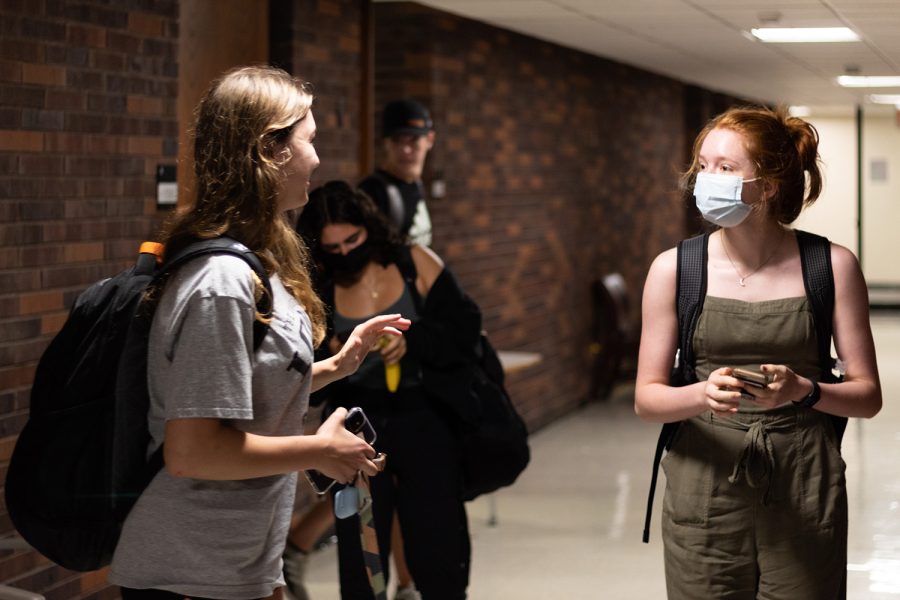UI departments face overflowing class sections, shortage of instructors
Two students are seen talking after class in the English Philosophy Building at the University of Iowa on Wednesday, Aug. 25, 2021. While masks are not required, some students still opt to wear masks on campus.
August 21, 2022
With students returning to campus, University of Iowa departments are scrambling to find professors to teach added sections as classes are filled to the brim.
The number of students in the class of 2026 is not yet known, but the university has dealt with large classes before. The UI will release class size estimates in September.
The class of 2024 has 4,530 students and the class of 2025 has 4,521 students according to the university.
Chris Brewer, the UI’s public relations manager, wrote in an email to The Daily Iowan that the university was able to follow the procedures already in place to accommodate the large number of students during course registration.
“University policy is to provide enrollment numbers 10 days after the start of every semester, but we are very pleased with our pool of applicants and admitted students this year,” Brewer wrote. “It is gratifying to see that the University of Iowa continues to be the first choice for so many students and it is exciting to welcome so many students to campus this week.”
When students register for classes, they work with academic advisors that help them join classes that interest them, he wrote.
“Sometimes [students] do not get their first choice for all courses, but we do everything we can to find courses that match their interests,” Brewer wrote. “Our advisors have continued to work with students to adjust schedules as necessary. Because of their hard work, all our incoming students will be able to take courses this fall that help them progress toward their degree.”
The academic advising team worked with colleges throughout the UI to help open spots up in classes and find ways to accommodate the number of incoming students, he wrote.
Through those efforts, the university was able to have a head start before the numbers became too much to handle.
“Departments were able to open additional seats, instructors shifted to a related course where there was need, and we communicated with students as seats became available,” Brewer wrote. “In the final two weeks of summer course registration, we added capacity in more than 50 introductory courses and created 10-20 new course sections.”
For the UI physics and astronomy department, the work to create more classes began in May.
Misty Lyon, UI assistant to the departmental executive officer for physics and astronomy, said the high number of students enrolling in larger classes was evident quickly.
“I would say back in May, we kind of thought that we had already reached where we have been in a previous fall for registration, and we were kind of like, at that point, trying to figure out, okay, what do we need to do here to get the students enrolled,” she said.
The department added sections of courses like College Physics I to accommodate all student’s needs. Last fall, the course had 277 students enrolled. According to Lyon, 355 students are enrolled so far this fall.
While more students are joining classes, online lectures are also helping accommodate the large number. The UI is also offering some courses online, allowing students to join the class without needing a physical seat in a lecture hall.
RELATED: UI faculty, staff continue to struggle with burnout
The difficult part, Lyon said, is finding open spots in courses that require a lab section along with a lecture.
“Luckily, our lecture portion of this bigger course was online and the other ones we’ve just kind of been lucky and had enough seats in the lectures, but some of the labs we just have to find times that we don’t have something in that lab,” Lyon said.
The solution is usually to add a lab section early in the morning or later at night when spaces are available and not being used by other classes.
Departments across the university are also adding more course sections, from pre-med classes to literature.
Loren Glass, chair of the UI English department, said the department is also facing a high number of incoming students. The main impact of the increase in numbers is on general education classes like The Interpretation of Literature.
“Basically, just over the summer, we had to, with a certain amount of urgency, add a bunch of sections and find folks to teach them,” Glass said. “…the number of people that we have available to teach gen ed lit has actually diminished somewhat, so we had to actually sort of dig down and one of my faculty is even coming out of retirement to teach a gen ed lit class.”
Glass said the department reached the end of its list of people to teach classes and still needs more instructors. There are still waitlists for most classes in the English department, even with over 50 sections of some courses.
“We’re just doing our best to accommodate. If you go look at MyUI, you’ll see that almost every single class in our major is waitlisted,” Glass said. “The English and creative writing major is a destination major. We recruit a lot of students to come in and we’re still working to adjust our faculty to the demands of that major.”
The increase in classes will mainly impact the graduate students, adjunct professors, and visitors who are teaching the courses but are not contracted faculty, Glass said.
While they have people to teach the classes now, Glass is taking the “overwhelming and unexpected” experience as a lesson for the future.
“I perceive this as a sort of warning that our major is going to continue to grow,” Glass said. “…We are bringing in a lot of out-of-state undergrads and so just long term, I’m anticipating increasing need in the English department for faculty to teach.”



